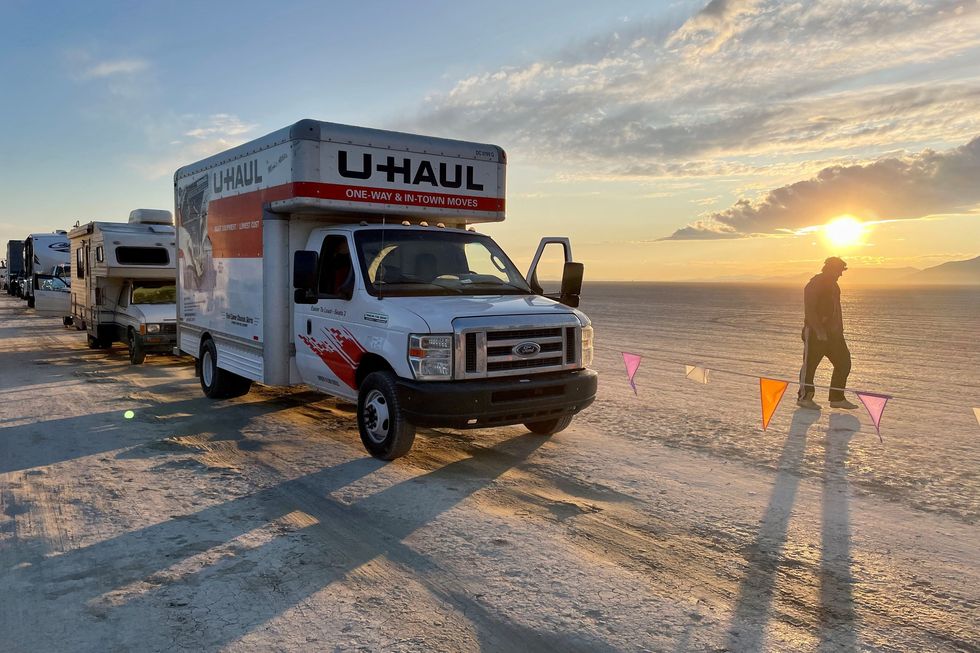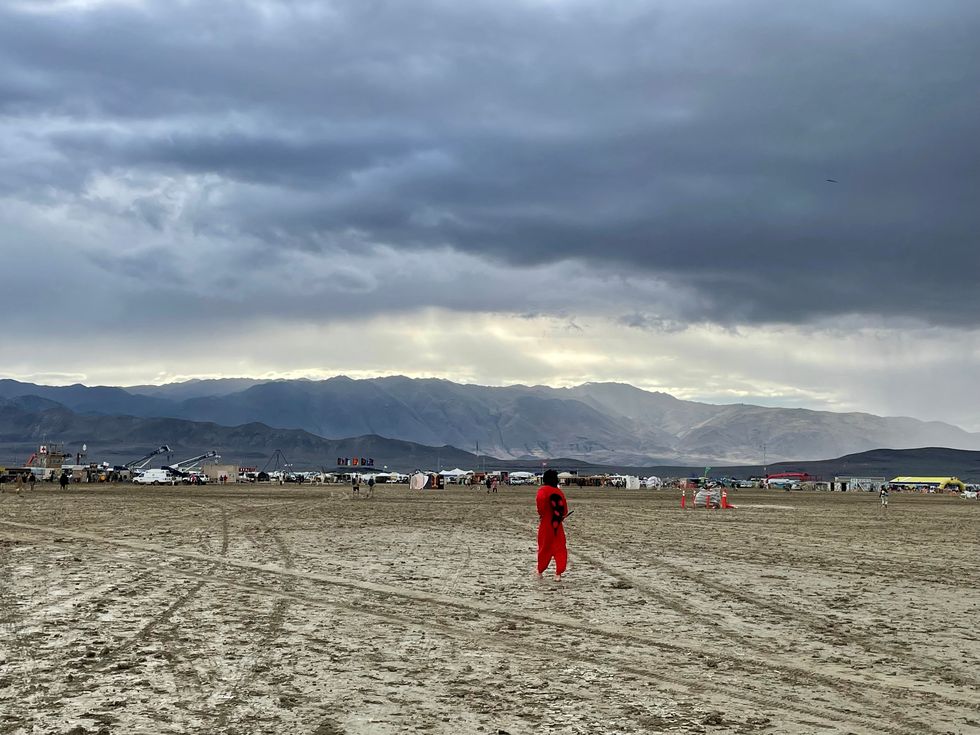This article originally appeared on Esquire US.
I’m filling my RV with five gallons of extra gas when a guy wearing nothing but hot pink booty shorts, covered in mud, and smoking a cigarette comes up behind me. “You know what I love about Burning Man?” he asks, unprompted, flicking his lit Newport in my direction. “It’s completely unpredictable.”
This is my sixth Burning Man. Just when I think I’ve seen all the blinding dust storms, psychedelic misadventures, and porta-potty horrors that are humanly possible, the most unimaginable thing happens. On Friday evening, the skies open and dump torrential rains, transforming the dry alkaline lake bed—where the event is traditionally held—into a muddy hellscape, where it’s impossible to walk more than a few hundred feet, let alone ride a bike or drive a motor vehicle. I confer with my campmates. Eventually, we decide to shelter in place. These are writers, human rights attorneys, builders, bike shop owners, and employees at small startups. We aren’t the glittering social media darlings (known as sparkle ponies) taking obnoxious selfies at sunrise. We aren’t celebrities like Diplo or Chris Rock or Cara Delevingne or Austin Butler who will get lifted out by fans. We are very firmly Burning Man’s dirty, dusty middle class—and no one is coming to our rescue.
Not knowing when we can depart, we decide to make the most of it on Saturday night. We hit a few parties within walking distance and get back to our camp at 5:30 in the morning. (This is considered an early bedtime at Burning Man.) Black Rock City—the name of the temporary metropolis where Burning Man is held—will supposedly get hit with another storm in the early morning hours and conditions will worsen. The access road that leads to the gate connecting Burning Man to highway 34 and the real world remains closed. I fall asleep fully expecting to find an even wetter, more horrifying playa in the afternoon.
At 9 A.M., my campmate Marissa (the human rights attorney) wakes me up and says she received a text from a friend who was able to drive out in the morning. The rains that had been expected to hit in the early morning hours had missed the playa and the main gate—while not officially open—was allowing people to exit. Conditions were still muddy, but dry enough for some people to drive 4x4s out. “Oh wait,” Marissa says, “my friend says there are apparently two rivers we have to cross on the way out.”
I grab my cousin Bella, scale a nearby tower, and spot a few jeeps and RVs in the distance slowly making their way out of the city. The road in front of my camp seems dry enough to drive over. I do a gut check and then talk with the rest of my campmates. We feel like we have a small window to make an escape from Black Rock City. I slam two coffees, take a couple of drags of nicotine from a vape pen, and chase it with a few milligrams of Modafinil. We load the RV in under an hour and after combing our camp for debris as small as a carpet fiber (a central principle of Burning Man is to leave no trace) we pile into the RV. I put it in drive and slowly inch out.
A few months ago, Kevin Sintumuang, Esquire’s director of lifestyle and culture, sent me to Palm Springs to drive the Lamborghini Huracán Sterrato, a sports car designed to go off-road. During the course of the event, a professional driver from Lambo gave me intense instruction on how to drive, drift, and manoeuvre effectively over everything from bumpy and dusty terrain to muddy and slick off-road surfaces. At the end of the event, I could slide the 3,200-pound sports car sideways into a drift on an almost friction-free muddy patch. The key, the Lambo instructor told me, was to drive by feel.
The urban planning of Black Rock City is a series of concentric circles laid out like a watch dial. Streets that radiate out from the centre correspond to times on a watch dial–9:00 o’clock, 7:00 o’clock, 6:30 o’clock, etc. Meanwhile, streets that form concentric circles correspond to letters of the alphabet—A street, B street, C street, and so on. Our camp was located at approximately 9:35 and G. I had to get our RV to the access road, located at 6:30 and K, several miles away.
We headed down G street since it seemed fairly dry. Cousin Bella rode shotgun looking for the driest path possible, while my friend Julian acted as spotter, scanning the environment for people and objects to make sure we didn’t hit them.
It was when we hit 8:30 and G when things started to turn bad. I had already gunned the engine over several muddy patches, sending the 30-foot-long RV into a drift, but still remaining easily in control. We reached a deeply rutted lubricious area about 50 yards long when the wheels began to spin. Our speed rapidly decreased from 20 miles per hour (way too fast in the city limits I know), to maybe five miles per hour, then to a crawl. And then we were still. “Shit we’re stuck,” I muttered to myself as intrusive thoughts of furious, violent Burners swarming our RV began to pop into my brain. I took a breath and the words from the Lambo instructor echoed in my head. “Drive by feel.”
I tossed the RV into reverse and managed to back up a few inches. Cousin Bella shouted that she saw a dry patch of dirt on our starboard side. I cranked the wheel as far as it would go to the right and floored the gas. Our wheels caught the dry patch and we started moving again. Slowly. We could no longer stay on G. At the next intersection, we decided to hang a right and get on K street. After what seemed like hours—it was maybe 20 minutes—we reached the access road that would lead to the gate.
The next few miles on the access road to the gate were oddly smooth and calm. A few other scattered RVs, 4x4s, and sedans drove along the bumpy, sometimes muddy route with us. After a few miles, we could see the faint outline of cars turning onto the asphalt of highway 34 before us. Escape was maybe 500 yards away. Traffic slowed down to a crawl and then a stop.
We turned and emerged in front of the “rivers” Marissa had mentioned earlier. A muddy stream that was maybe ten feet wide and unknowably deep lay before us. A Dodge Charger to my right approached the river going 10 miles per hour, only to get stuck midway, wheels spinning. Just as the occupant stepped out and went to his knees in mud, I made a wide turn, put 200 yards of distance between the RV and the river, and punched the accelerator. Drive by feel.
The RV hit the river going between 45 and 65 miles per hour–I’m not quite sure exactly how fast–and mud splattered all over the front end, blinding us. Every object that was not secured in the back of the RV. Bikes, propane tanks, and jars of pickles flew in the air. I slowed the vehicle to a stop, turned on the windshield wipers, and looked in my side-view mirror. The river was claiming more victims, but those who ripped through it at high velocity were able to clear it. Speed was the key.
I didn’t hesitate flying through the second river at around 60 miles per hour. “Oh god!” yells Cousin Bella as we were coated in a second helping of mud and gunk. (For his part, Julian remained calm through the ordeal and giggled slightly through the more harrowing sections.)
Two hundred yards from the road, we hit a traffic jam. One more groggy patch lay before us and countless vehicles were getting trapped in deep, sticky pockets of mud. There was no law enforcement to be seen; the BLM officers who normally patrol Black Rock City had tucked tail and ran when the rains hit. We sit for an hour until an orange sprinter van in front of us turns off the road and made its way down a path that initially looked too slippery to safely traverse. “If that van makes it to the highway, we’ll follow,” I tell Cousin Bella and Julian. They nod in agreement.
The orange sprinter slowly makes its way down into a deep rut, powers through, and inches up to the highway. We follow suit. Within 15 minutes, our tires touch asphalt and my crew breathes a collective sigh of relief. High fives, handshakes, cheering. It takes another twelve hours to make it back home in San Francisco.
My friend Dalton—who is also a Burner—once told me, “Burning Man doesn’t really change. You do. That’s why it feels different every year.” After this experience, I’m not sure if Burning Man or I will ever be quite the same. I have a personal theory about the human psyche: that during complex, stressful experiences, we tend to forget the terrible parts and retain the memories of what was beautiful.
Will I return to Burning Man next year? I’m not sure. Ask me again in six months, though, and I’ll probably give an emphatic, “Yes!”
















